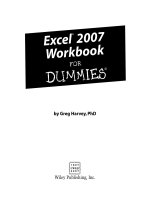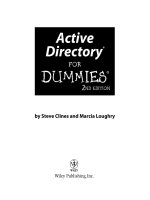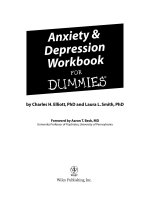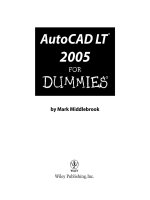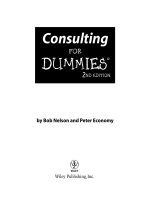anxiety & depression workbook for dummies (isbn - 0764597930)
Bạn đang xem bản rút gọn của tài liệu. Xem và tải ngay bản đầy đủ của tài liệu tại đây (6.39 MB, 302 trang )
by Charles H.Elliott,PhD and Laura L. Smith, PhD
Foreword by Aaron T. Beck, MD
University Professor of Psychiatry,University of Pennsylvania
Anxiety &
Depression
Workbook
FOR
DUMmIES
‰
01_597930 ffirs.qxd 9/28/05 2:18 PM Page i
01_597930 ffirs.qxd 9/28/05 2:18 PM Page iv
by Charles H.Elliott,PhD and Laura L. Smith, PhD
Foreword by Aaron T. Beck, MD
University Professor of Psychiatry,University of Pennsylvania
Anxiety &
Depression
Workbook
FOR
DUMmIES
‰
01_597930 ffirs.qxd 9/28/05 2:18 PM Page i
Anxiety & Depression Workbook For Dummies
®
Published by
Wiley Publishing, Inc.
111 River St.
Hoboken, NJ 07030-5774
www.wiley.com
Copyright © 2006 by Wiley Publishing, Inc., Indianapolis, Indiana
Published by Wiley Publishing, Inc., Indianapolis, Indiana
Published simultaneously in Canada
No part of this publication may be reproduced, stored in a retrieval system, or transmitted in any form or by any means,
electronic, mechanical, photocopying, recording, scanning, or otherwise, except as permitted under Sections 107 or 108 of
the 1976 United States Copyright Act, without either the prior written permission of the Publisher, or authorization through
payment of the appropriate per-copy fee to the Copyright Clearance Center, 222 Rosewood Drive, Danvers, MA 01923,
978-750-8400, fax 978-646-8600. Requests to the Publisher for permission should be addressed to the Legal Department,
Wiley Publishing, Inc., 10475 Crosspoint Blvd., Indianapolis, IN 46256, 317-572-3447, fax 317-572-4355, or online at
/>Trademarks: Wiley, the Wiley Publishing logo, For Dummies, the Dummies Man logo, A Reference for the Rest of Us!, The
Dummies Way, Dummies Daily, The Fun and Easy Way, Dummies.com and related trade dress are trademarks or registered
trademarks of John Wiley & Sons, Inc. and/or its affiliates in the United States and other countries, and may not be used
without written permission. All other trademarks are the property of their respective owners. Wiley Publishing, Inc., is not
associated with any product or vendor mentioned in this book.
LIMIT OF LIABILITY/DISCLAIMER OF WARRANTY: THE CONTENTS OF THIS WORK ARE INTENDED TO FURTHER GEN-
ERAL SCIENTIFIC RESEARCH, UNDERSTANDING, AND DISCUSSION ONLY AND ARE NOT INTENDED AND SHOULD NOT BE
RELIED UPON AS RECOMMENDING OR PROMOTING A SPECIFIC METHOD, DIAGNOSIS, OR TREATMENT BY PHYSICIANS
FOR ANY PARTICULAR PATIENT. THE PUBLISHER AND THE AUTHOR MAKE NO REPRESENTATIONS OR WARRANTIES
WITH RESPECT TO THE ACCURACY OR COMPLETENESS OF THE CONTENTS OF THIS WORK AND SPECIFICALLY DIS-
CLAIM ALL WARRANTIES, INCLUDING WITHOUT LIMITATION ANY IMPLIED WARRANTIES OF FITNESS FOR A PARTICU-
LAR PURPOSE. IN VIEW OF ONGOING RESEARCH, EQUIPMENT MODIFICATIONS, CHANGES IN GOVERNMENTAL
REGULATIONS, AND THE CONSTANT FLOW OF INFORMATION RELATING TO THE USE OF MEDICINES, EQUIPMENT, AND
DEVICES, THE READER IS URGED TO REVIEW AND EVALUATE THE INFORMATION PROVIDED IN THE PACKAGE INSERT
OR INSTRUCTIONS FOR EACH MEDICINE, EQUIPMENT, OR DEVICE FOR, AMONG OTHER THINGS, ANY CHANGES IN THE
INSTRUCTIONS OR INDICATION OF USAGE AND FOR ADDED WARNINGS AND PRECAUTIONS. READERS SHOULD CON-
SULT WITH A SPECIALIST WHERE APPROPRIATE. THE FACT THAT AN ORGANIZATION OR WEBSITE IS REFERRED TO IN
THIS WORK AS A CITATION AND/OR A POTENTIAL SOURCE OF FURTHER INFORMATION DOES NOT MEAN THAT THE
AUTHOR OR THE PUBLISHER ENDORSES THE INFORMATION THE ORGANIZATION OR WEBSITE MAY PROVIDE OR REC-
OMMENDATIONS IT MAY MAKE. FURTHER, READERS SHOULD BE AWARE THAT INTERNET WEBSITES LISTED IN THIS
WORK MAY HAVE CHANGED OR DISAPPEARED BETWEEN WHEN THIS WORK WAS WRITTEN AND WHEN IT IS READ.
NO WARRANTY MAY BE CREATED OR EXTENDED BY ANY PROMOTIONAL STATEMENTS FOR THIS WORK. NEITHER THE
PUBLISHER NOR THE AUTHOR SHALL BE LIABLE FOR ANY DAMAGES ARISING HEREFROM.
For general information on our other products and services, please contact our Customer Care Department within the U.S.
at 800-762-2974, outside the U.S. at 317-572-3993, or fax 317-572-4002.
For technical support, please visit www.wiley.com/techsupport.
Wiley also publishes its books in a variety of electronic formats. Some content that appears in print may not be available in
electronic books.
ISBN-13: 978-0-7645-9793-0
ISBN-10: 0-7645-9793-0
Manufactured in the United States of America
10 9 8 7 6 5 4 3 2 1
1B/RX/RQ/QV/IN
01_597930 ffirs.qxd 9/28/05 2:18 PM Page ii
About the Authors
Charles H. Elliott, PhD, is a clinical psychologist and a member of the faculty at Fielding
Graduate University. He is a Founding Fellow in the Academy of Cognitive Therapy, an inter-
national organization that certifies cognitive therapists. He has a part-time private practice
in Albuquerque, New Mexico, that specializes in the treatment of anxiety and depression. In
addition, he has written many articles and book chapters in the area of cognitive behavior
therapies. He has made numerous presentations nationally and internationally on new devel-
opments in assessment and therapy of emotional disorders. He is coauthor of Depression
For Dummies (Wiley), Overcoming Anxiety For Dummies (Wiley), Why Can’t I Get What I Want?
(Davies-Black, 1998; A Behavioral Science Book Club Selection), Why Can’t I Be the Parent I
Want to Be? (New Harbinger Publications, 1999), and Hollow Kids: Recapturing the Soul of a
Generation Lost to the Self-Esteem Myth, (Prima, 2001).
Laura L. Smith, PhD, is a clinical psychologist at the Presbyterian Medical Group, Behavioral
Medicine Outpatient Clinic in Albuquerque, New Mexico. She specializes in the assessment
and treatment of both adults and children with depression, anxiety, and other emotional dis-
orders. In addition, she has presented on cognitive therapy and mental health issues to
both national and international audiences. Dr. Smith is coauthor of Depression For Dummies
(Wiley), Overcoming Anxiety For Dummies (Wiley), Hollow Kids: Recapturing the Soul of a
Generation Lost to the Self-Esteem Myth, (Prima, 2001) and Why Can’t I Be the Parent I Want
to Be? (New Harbinger Publications,1999).
Drs. Elliott and Smith are available for speaking engagements and workshops. You can visit
their Web site at
www.PsychAuthors.com.
01_597930 ffirs.qxd 9/28/05 2:18 PM Page iii
01_597930 ffirs.qxd 9/28/05 2:18 PM Page iv
Dedication
We dedicate this book to our kids: Alli, Brian, Grant, Nathan, Sara, and Trevor. And to our
granddaughter: Lauren Melodie. And finally to our parents: Edna Louise Smith, Joe Bond
Elliott, Tea Elliott, William Thomas Smith (1914-1999), and Suzanne Wieder Elliott (1923–2004).
Acknowledgments
We’re no longer in denial. We’re hopelessly addicted to this writing business. We no longer
need to apologize to our family and friends for our neglect; they’re used to it by now!
We appreciate the efforts of our agents, Ed and Elizabeth Knappman who have encouraged
our pursuits. Thanks to our editors at Wiley: Mikal Belicove, Tim Gallan, and Elizabeth Rea.
We would not be able to function without help from Audrey Hite. Special thanks to Scott Love
at Softekllc.com, who designed our Web site and keeps our computers happy. Thanks also to
Elizabeth Deardorf for making our dogs smile in our authors’ picture.
Finally, we have been privileged to hear the many stories of suffering, hurt, trauma, hope,
recovery, and resilience from our clients over the years. We respect and appreciate what
they have taught us. This book would not be possible without their collective wisdom.
01_597930 ffirs.qxd 9/28/05 2:18 PM Page v
Publisher’s Acknowledgments
We’re proud of this book; please send us your comments through our Dummies online registration form located at
www.dummies.com/register/.
Some of the people who helped bring this book to market include the following:
Acquisitions, Editorial, and Media Development
Senior Project Editor: Tim Gallan
Acquisitions Editors: Mikal Belicove, Mike Lewis
Copy Editor: Elizabeth Rea
Editorial Program Assistant: Courtney Allen
Technical Editor: Linda Ames
Editorial Manager: Christine Meloy Beck
Editorial Assistants: Nadine Bell, David Lutton,
Hanna Scott
Cover Photos: © Tim Brown, Stone, Getty Images
Cartoons: Rich Tennant (
www.the5thwave.com)
Composition Services
Project Coordinator: Adrienne Martinez
Layout and Graphics: Lauren Goddard, Denny Hager
Proofreaders: Leeann Harney, Sandra Profant
Indexer: Naomi Linzer
Publishing and Editorial for Consumer Dummies
Diane Graves Steele, Vice President and Publisher, Consumer Dummies
Joyce Pepple, Acquisitions Director, Consumer Dummies
Kristin A. Cocks, Product Development Director, Consumer Dummies
Michael Spring, Vice President and Publisher, Travel
Kelly Regan, Editorial Director, Travel
Publishing for Technology Dummies
Andy Cummings, Vice President and Publisher, Dummies Technology/General User
Composition Services
Gerry Fahey, Vice President of Production Services
Debbie Stailey, Director of Composition Services
01_597930 ffirs.qxd 9/28/05 2:18 PM Page vi
Contents at a Glance
Foreword xv
Introduction 1
Part I: Analyzing Angst and Preparing a Plan 7
Chapter 1: Sorting Out Signs of Anxiety and Depression 9
Chapter 2: Discovering the Beginnings 19
Chapter 3: Overcoming Obstacles to Change 31
Chapter 4: Minding Your Moods 43
Part II: Thinking About Thinking: Thought Therapy 55
Chapter 5: Untangling Twisted Thinking 57
Chapter 6: Indicting and Rehabilitating Thoughts 77
Chapter 7: Correcting Your Life-Lenses: A New Vision 99
Chapter 8: Managing Mindfulness and Achieving Acceptance 117
Part III: Actions Against Angst: Behavior Therapy 129
Chapter 9: Facing Feelings: Avoiding Avoidance 131
Chapter 10: Lifting Mood Through Exercise 149
Chapter 11: Entertaining Enjoyment 159
Chapter 12: Getting Moving and Tackling Life’s Problems 169
Part IV: Phocus on Physical Pheelings 181
Chapter 13: Relaxing the Heart and Soul 183
Chapter 14: Making the Medication Decision 197
Part V: Relationship Therapy 205
Chapter 15: Restoring Relationships 207
Chapter 16: Smoothing Out Conflict 219
Part VI: Looking Beyond Anxiety and Depression 231
Chapter 17: Reining In Relapse 233
Chapter 18: Promoting Positives 247
Part VII: The Part of Tens 261
Chapter 19: Ten Resources for Help 263
Chapter 20: Ten Quick Ways Out of Upset 267
Index 271
02_597930 ftoc.qxd 9/28/05 2:18 PM Page vii
02_597930 ftoc.qxd 9/28/05 2:18 PM Page viii
Table of Contents
Foreword xv
Introduction 1
About This Book 1
A Note to Our Depressed and Anxious Readers 2
How to Use This Book 2
What Not to Read 2
What We Assume About You 2
How This Book Is Organized 3
Part I: Analyzing Angst and Preparing a Plan 3
Part II: Thinking About Thinking: Thought Therapy 3
Part III: Actions Against Angst: Behavior Therapy 3
Part IV: Phocus on Physical Pheelings 3
Part V: Relationship Therapy 4
Part VI: Looking Beyond Anxiety and Depression 4
Part VII: The Part of Tens 4
Characters in This Book 4
Icons Used in This Book 4
Where to Go from Here 5
Part I: Analyzing Angst and Preparing a Plan 7
Chapter 1: Sorting Out Signs of Anxiety and Depression 9
Dwelling on Dismal and Worried Thoughts 9
Walking in Quicksand: Apprehensive and Blue Behavior 11
Feeling Funky 11
Reflecting upon Relationships 12
Plotting Your Personal Problems Profile 13
Choosing Your Challenge 15
Knowing When to Get More Help 17
Chapter 2: Discovering the Beginnings 19
Building the Body Connection 19
Laying Out a Lifeline 20
Surveying Stress 28
Drawing Conclusions 30
Chapter 3: Overcoming Obstacles to Change 31
Discovering and Challenging Change-Blocking Beliefs 31
Detecting beliefs standing in your way 31
Blasting through beliefs blocking your path 34
Looking Out for Self-Sabotage 38
Stopping self-sabotage 39
Rewriting your self-sabotaging scripts 41
02_597930 ftoc.qxd 9/28/05 2:18 PM Page ix
Chapter 4: Minding Your Moods 43
Deciphering Body Signals 43
Connecting the Mind and Body 46
Putting Events, Feelings, and Sensations Together 47
Becoming a Thought Detective 50
Part II: Thinking About Thinking: Thought Therapy 55
Chapter 5: Untangling Twisted Thinking 57
The Information Reality Scramblers 57
Recording Information Reality Scramblers on Thought Trackers 60
The Self-Judging Reality Scramblers 64
Shoulding on yourself 64
Making critical comparisons 66
Tagging yourself with loathsome labels 68
The Self-Blame Reality Scrambler 72
Doing What You Can to Solve the Problem 74
Chapter 6: Indicting and Rehabilitating Thoughts 77
From Arraignment to Conviction: Thought Court 77
Examining a sample case in Thought Court 78
Putting your thoughts on trial 81
Reviewing more Thought Court cases 84
After the Verdict: Replacing and Rehabilitating Your Thoughts 87
Getting a little help from a friend 88
Traveling to the future 89
Recalculating risks 92
Imagining the worst 94
Reflections on Chapter 6 97
Chapter 7: Correcting Your Life-Lenses: A New Vision 99
Examining Life-Lenses 99
How life-lenses work 102
The origins of life-lenses 105
Changing the Prescription of Your Life-Lenses 107
Distinguishing the past from the present 107
Tallying up costs and benefits of current life-lenses 110
Taking direct action against problematic life-lenses 113
Chapter 8: Managing Mindfulness and Achieving Acceptance 117
Start by Losing Your Mind! 117
Distinguishing between observing and evaluating 117
Tuning in and tuning out mind chatter 120
Playing with your mind chatter 121
Arriving at Acceptance 123
Connecting with Now 126
Part III: Actions Against Angst: Behavior Therapy 129
Chapter 9: Facing Feelings: Avoiding Avoidance 131
What, Me Worry? 131
Building a Staircase of Fear 134
x
Anxiety & Depression Workbook For Dummies
02_597930 ftoc.qxd 9/28/05 2:18 PM Page x
Identifying your fears 134
Surveying sample staircases of fear 138
Creating your own Staircase of Fear 141
Climbing Your Staircase 142
Exposing Obsessive-Compulsive Disorder 145
Beating obsessions 146
Treating compulsions 147
Chapter 10: Lifting Mood Through Exercise 149
How Much Is Enough? 149
The Case for Health Improvement 150
Fitting Exercise into Your Life 152
What to Do When Willpower Wilts 154
Fighting de-motivating thoughts 154
Keeping track of your prgress 157
Chapter 11: Entertaining Enjoyment 159
What’s Your Pleasure? 159
Poisonous Pleasures 162
Pleasure Busters 163
Deciding to deserve fun 163
Finding fun frivolous? 165
Pleasure-pooping predictions 166
Chapter 12: Getting Moving and Tackling Life’s Problems 169
The Motivation Myth 169
Scoring Goals with S.O.C.C.E.R 172
Sizing things up (S) 172
Collecting options (O) 173
Considering consequences (C) 175
Making a choice (C) 178
Working up the courage (E) 178
Letting it rip (R) 179
Part IV: Phocus on Physical Pheelings 181
Chapter 13: Relaxing the Heart and Soul 183
Relaxation: What’s in It for Me? 183
Breathing Tension Away 185
Abdominal breathing 185
Anti-panic breathing 185
Gentle breathing 186
Mellowing Your Muscles 187
Getting Your Zzzzzzz’s 189
Sleep situation #1: Watching what you eat and drink 191
Sleep situation #2: Watching what you do 191
Sleep situation #3: The sleep setting 191
Sleep situation #4: How long is too long? 192
Sleep situation #5: Waking up too much? 192
Sleep situation #6: When worries keep you awake 193
Sleep situation #7: Dream demons 194
Your sleep action plan 195
xi
Table of Contents
02_597930 ftoc.qxd 9/28/05 2:18 PM Page xi
Chapter 14: Making the Medication Decision 197
To Take or Not to Take 197
Preparing Your Prescriber 200
Sizing Up Side Effects 202
Part V: Relationship Therapy 205
Chapter 15: Restoring Relationships 207
Revealing the Emotion-Relationship Connection 207
Enhancing Your Relationship 209
Talking together 209
Delightful doings 212
Dealing with Relationship Loss 214
Moving on 215
Becoming active 217
Chapter 16: Smoothing Out Conflict 219
Overriding Defensiveness 219
Shining the light on your defensive behavior 220
Check, please 222
Don’t refuse to defuse 223
Discovering the Problem Isn’t All About You 224
Talking About the Tough Stuff 228
Shifting the focus with I Messages 228
Softening the blow through buffering 229
Part VI: Looking Beyond Anxiety and Depression 231
Chapter 17: Reining In Relapse 233
Sizing Up Your Risk of Relapse 233
Not Letting Relapse Sneak Up on You 234
Having a Fire Extinguisher Ready 237
Keeping the Ball Rolling 240
Doing the right things 241
Disrupting satisfaction interrupters 242
Chapter 18: Promoting Positives 247
Focusing on Gratitude 247
Keeping track of the things that make you grateful 248
Writing testimonials 250
Making the World a Bit Nicer 252
Letting Go 253
Exercising Self-Control 255
Discovering What’s Really Important 256
Finding Meaning at Your Funeral 258
Part VII: The Part of Tens 261
Chapter 19: Ten Resources for Help 263
Spending Time with Self-Help Books 263
Browsing Helpful Web Sites 264
xii
Anxiety & Depression Workbook For Dummies
02_597930 ftoc.qxd 9/28/05 2:18 PM Page xii
Participating in Support Groups 265
Checking In with Primary Care Doctors 265
Sharing with Psychiatrists 265
Getting a Hand from Psychologists 265
Talking Things Through with Counselors 265
Getting Extra Help from Social Workers 266
Taking Advantage of Community Centers 266
Leaning on Family and Friends 266
Considering the Best Options for You 266
Chapter 20: Ten Quick Ways Out of Upset 267
Just Breathe 267
Talk It Out 267
Get Soaked 267
Feel the Big Chill 268
Take a Quick Thought Challenge 268
Exorcise with Exercise 269
Mellow with Music 269
Pacify with Pets 269
Distract Your Distress 269
Stay in the Present 269
Figure Out What Works for You 270
Index 271
xiii
Table of Contents
02_597930 ftoc.qxd 9/28/05 2:18 PM Page xiii
02_597930 ftoc.qxd 9/28/05 2:18 PM Page xiv
Foreword
N
ot long ago I wrote the following foreword for the book, Depression For Dummies.
As the current Anxiety & Depression Workbook For Dummies is a companion to that
book as well as Overcoming Anxiety For Dummies, I believe the previous foreword is both
germane and worth repeating, followed by some specific comments about the current work.
“I am very pleased that Drs. Charles Elliott and Laura Smith have reviewed
and distilled the scientific literature on the treatment of depression for the
general public. This book is uniquely comprehensive in that it thoroughly
covers the scientifically validated treatments for depression, including behav-
ior therapy, medications, interpersonal therapy, and cognitive therapy. The
authors have also included promising ideas based on mindfulness and posi-
tive psychology. However, they have chosen to emphasize the importance of
cognitive therapy because no other therapy has received as much support as
cognitive therapy for the treatment of depression.
Thus, Drs. Elliott and Smith have woven important cognitive therapy princi-
ples into their presentation of the other validated approaches to depression.
This decision is appropriate since research has suggested that some of these
other therapies may in fact work due in part to the cognitive therapy strate-
gies embedded within them.
I believe a word about cognitive therapy is in order. In the late 1950s, I began
developing cognitive therapy. At the time, I was dissatisfied with the lack of
evidence supporting the value of the prevailing psychotherapy — Freudian
psychoanalysis — in treating depression. Cognitive therapy quickly became
established as a highly effective treatment for depression, a finding that
has been verified in numerous subsequent clinical trials. Over the ensuing
decades, cognitive therapy has also demonstrated excellent outcomes in the
treatment of problems with anger, anxiety, panic disorder, stress, relationship
problems, substance abuse, eating disorders, and most recently, even schizo-
phrenia. To date, no other psychotherapy has demonstrated such consistent
effectiveness across a broad swath of problems. Depression For Dummies
does a marvelous job of providing readers with the core techniques and prin-
ciples of cognitive therapy as applied to depression.
I feel it’s important to note that Depression For Dummies is not a book for
dummies! Rather, this book lays out the principles of cognitive therapy, as
well as other validated psychotherapies, in exceptionally clear terms. Drs.
Elliott and Smith include fascinating clinical examples and effective exercises
within the most reader-friendly, entertaining format I’ve seen in a book of this
genre. I have no doubt it will prove to be a powerful self-help resource as well
as an adjunct to psychotherapy.
I have known Dr. Elliott since the early 1980s, when he was a highly skillful
cognitive therapist serving in a major psychotherapy outcome study. I recall
last encountering Drs. Elliott and Smith just a few years ago at an interna-
tional conference on cognitive therapy in Catania, Italy. They presented at
this conference as part of their honeymoon. Such dedication to cognitive
therapy!
03_597930 flast.qxd 9/28/05 2:19 PM Page xv
If you struggle with depression, I strongly recommend Depression For
Dummies. These authors convey considerable compassion, empathy, and
insight in addition to unusual clarity.”
At this time, I am especially pleased to see that Drs. Elliott and Smith have written a compan-
ion workbook called Anxiety & Depression Workbook For Dummies. This workbook gives you
the basic essentials of each therapeutic strategy. After providing the rudimentary under-
standing you need, it quickly shows ways to put that information to work in your own life.
You won’t have to spend hours reading about technical jargon and irrelevant material.
Almost everything in this book can be immediately applied to improving the way you feel,
behave, and think. In addition, the authors have made the process amazingly painless. The
exercises are highly engaging, and Drs. Elliott and Smith weave humor throughout that man-
ages not to demean or condescend. You might just have a good time with this workbook!
Aaron T. Beck, MD
University Professor of Psychiatry
University of Pennsylvania
xvi
Anxiety & Depression Workbook For Dummies
03_597930 flast.qxd 9/28/05 2:19 PM Page xvi
Introduction
D
o you worry too much? Are you often sad or down in the dumps? Do you have to drag
yourself out of bed in the morning? Or maybe you avoid people more than you should.
If so, you’re probably dealing with some type of anxiety or depression. Depression and anxi-
ety are serious problems — they darken vision and distort thinking while draining joy and
pleasure from life.
Everyone feels sad or worried from time to time. Unpleasant feelings are a normal part of
life. But when depression or anxiety interferes with your work, play, and/or relationships,
it’s time to take action.
Good news! You can conquer these problems. And the Anxiety & Depression Workbook For
Dummies will help. You can use this workbook on its own or as a supplement to counseling.
In either case, numerous studies show that self-help efforts work.
Experts estimate that almost a quarter of the people in the world will experience significant
problems with anxiety at some point in their lives. And between 15 and 20 percent will suc-
cumb to the ravages of depression at one point or another. Unfortunately, many people
suffer from both of these maladies. Over the years, we’ve known many clients, friends, and
family members who have anguished over anxiety or depression, but most of them have
found significant relief.
So if you struggle with anxiety, depression, or both, you’re not alone. We join you in your
battle by giving you research-based strategies and plenty of practice opportunities to help
you defeat depression and overcome anxiety.
About This Book
Our purpose in writing this book is to give you a wide range of skills and tools for managing
anxiety and depression. Although we touch on essential concepts about depression and
anxiety, this book is action-oriented — in other words, you have the opportunity to actively
apply our professional ideas to your life in meaningful ways.
No doubt you used workbooks in school. A math workbook may have helped you apply
math concepts to everyday problems. Or a reading workbook may have improved your abil-
ity to comprehend stories. Today, you can find workbooks on almost any topic, from selling
your home and succeeding on tests to preparing your taxes and improving your memory.
The purpose of any workbook is to lay out the basics of a topic and then provide numerous
opportunities to apply and practice the concepts at hand. Typically, books explain issues, and
workbooks help you master new skills. In other words, the Anxiety & Depression Workbook For
Dummies is “less talk — more action.”
Did you notice the “work” part of workbook? Don’t put this book back on the shelf quite yet!
You’ll be well paid for your work in the form of increased life satisfaction and reduced emo-
tional distress. And the work is actually rather interesting because you discover new ways
to live your life and get what you want.
04_597930 intro.qxd 9/28/05 2:19 PM Page 1
A Note to Our Depressed and Anxious Readers
Feeling depressed or anxious certainly isn’t funny. In fact, when you’re feeling this way,
you may find it quite difficult to see the humor in anything. Nevertheless, we’ve chosen to
include a little humor throughout this workbook. We understand that you may be offended
that we appear to make light of what is a dark, difficult subject, but humor is an important
coping tool. Our intention is to cheer you up a bit.
How to Use This Book
Unlike most workbooks, you don’t necessarily have to read and use the chapters of this
book in order, beginning to end. You can pick and choose what chapters to read and what
exercises to do, and you can also choose where to start and stop. We give you just enough
information to carry out the exercises and improve your moods.
This book is meant to be written in. Writing enhances skills and commits you to taking
action, so we strongly encourage you to do the work required for your recovery by writing
out your answers in the forms and worksheets. Don’t worry about your handwriting or
spelling — nobody’s grading your work.
Throughout this book, you’ll see sections labeled My Reflections. When you come across
a reflection space, we recommend that you take a little time to ponder what you’re feeling,
what you’ve discovered, and/or any new insights you’ve achieved. But hey, this is your
workbook — write down anything you want in My Reflections.
What Not to Read
Workbooks may conjure up memories of boredom and drudgery for you. Do you recall end-
less hours of mindless homework? Your teacher probably told you to fill out every single
page of each and every assignment, whether you’d mastered the skills or not.
Not in this book! We don’t tell you what you have to do. You can pick and choose which sec-
tions to read and which exercises to complete. Although we believe all our suggestions have
value, we encourage you to judge for yourself which exercises offer maximum benefit to you.
What We Assume About You
By the sheer fact that you’ve picked up this book, we assume, perhaps foolishly, that you
want to do something about depression and/or anxiety. We hope you already know a little
about these topics, but if you want to know more, we suggest you read either or both of
the companion books to this workbook: Overcoming Anxiety For Dummies (Wiley) and
Depression For Dummies (Wiley). Of course, we’re slightly biased toward these books
because we wrote them, but honestly, they’ll broaden your understanding of working
through emotional distress.
2
Anxiety & Depression Workbook For Dummies
04_597930 intro.qxd 9/28/05 2:19 PM Page 2
How This Book Is Organized
The Anxiety & Depression Workbook For Dummies is organized into seven parts, which we
outline in the following sections.
Part I: Analyzing Angst and Preparing a Plan
This part is all about helping you identify your problem and take the first small steps
toward recovery. Chapter 1 helps you discover whether you have a problem with anxiety or
depression. The quizzes in this chapter help you see where these problems show up in your
world and what they do to your thoughts, behaviors, feelings, and relationships. In Chapter 2,
you go on a journey to the origins of your problems with anxiety and depression because
knowing where it all began helps you realize that you’re not to blame. Because change some-
times feels overwhelming, Chapter 3 addresses self-sabotage and helps you keep moving
forward. Chapter 4 provides you with ways for keeping track of your moods and becoming
more aware of your thoughts.
Part II: Thinking About Thinking: Thought Therapy
The chapters in this part help you become a thought detective. In Chapter 5, you find out
how to examine your thoughts for distortions; then, in Chapter 6, you prosecute those dis-
torted thoughts and rehabilitate them.
Chapter 7 shows you how certain core beliefs darken and distort your view of yourself, your
world, and your future as surely as eyeglasses with the wrong prescription muddle normal
sight. We include tools for regrinding your life-lenses so you see things more clearly. Finally,
in Chapter 8, you have the opportunity to practice mindfulness and acceptance — more
techniques for handling troubling thoughts.
Part III: Actions Against Angst: Behavior Therapy
Chapter 9 spells out how you take direct action against the natural tendency to avoid what
makes you depressed or anxious. In Chapter 10, we get you up and moving by providing
workbook-type exercises that encourage physical exercise. When you’re depressed or anx-
ious, few activities sound like fun, so Chapter 11 has worksheets for reintroducing pleasure
into your life. Finally, Chapter 12 helps you tackle life problems that grow out of your emo-
tional distress.
Part IV: Phocus on Physical Pheelings
Addressing the physical side of distress is as important as addressing the mental or emo-
tional side. Excessive stress associated with anxiety and depression produces hormones
that ravage the body by increasing blood pressure and contributing to stomach problems,
weight gain, and heart disease. Therefore, relaxation techniques play an important role in
alleviating anxiety and depression. In Chapter 13, you find a variety of exercises for reducing
tension and stress. Because medication is an additional option for many people who are
depressed or anxious, Chapter 14 guides you through the decision of whether or not med-
ications are the right choice for you.
3
Introduction
04_597930 intro.qxd 9/28/05 2:19 PM Page 3
Part V: Relationship Therapy
Depression and anxiety can spill over and contaminate your relationships like sewage
dumped into a river. Good relationships offer support in dealing with emotional distress,
whereas spoiled relationships just make things worse. Chapter 15 helps you figure out if
your relationships are suffering, and the worksheets and exercises in Chapter 16 guide you
in improving the quality of your relationships.
Part VI: Looking Beyond Anxiety and Depression
After people overcome their anxiety and depression, naturally they prefer to go on with
their lives as though they’d never had a problem. Unfortunately, like the flu, you can catch
depression or anxiety more than once. Chapter 17 tells you how to prepare for and deal
with any setbacks in your condition, and Chapter 18 helps you develop positive habits that
lead to a more joyful, meaningful, and connected life.
Part VII: The Part of Tens
This part contains a couple of our top ten lists when it comes to the subject of anxiety and
depression. Chapter 19 recommends ten resources for getting help in dealing with your
depression and anxiety. If you’re looking for a quick way out of a bad mood, Chapter 20 is
for you — it lists ten remedies that don’t take a whole lot of effort.
Characters in This Book
Throughout this workbook, we use fictional characters to illustrate how you can complete
the various worksheets and exercises. Although these characters aren’t real people, they
represent composites of various clients and others we’ve known and worked with over the
years. Any resemblance to an actual individual, whether alive or deceased, is unintended
and coincidental. Nonetheless, we believe you’ll find yourself relating to these characters
and find their experiences useful.
Icons Used in This Book
Throughout the book, icons in the margins alert you to important types of information:
This icon marks particularly noteworthy information that we hope you’ll remember long
after you read this workbook.
This icon tells you it’s time to roll up your sleeves and get to work! It denotes a worksheet,
form, or exercise for you to fill out.
This icon points to specific examples that show you the way through worksheets or
exercises.
4
Anxiety & Depression Workbook For Dummies
04_597930 intro.qxd 9/28/05 2:19 PM Page 4
This icon appears when you need to take care; you may need professional help or should be
on the lookout for possible trouble.
This icon alerts you to especially useful insights and explanations.
Where to Go from Here
The Anxiety & Depression Workbook For Dummies can help you deal with your depression
and anxiety. It’s pragmatic, concrete, and goes straight to the point. As such, this workbook
doesn’t devote a lot of text to lengthy explanations or embellishments of basic concepts, so
you may wish to find out more about specific types of depression and anxiety, available
medications, and alternative treatments. For that purpose, we strongly recommend that you
consider reading one or both of the companion books, Depression For Dummies (Wiley) and
Overcoming Anxiety For Dummies (Wiley).
5
Introduction
04_597930 intro.qxd 9/28/05 2:19 PM Page 5
6
Anxiety & Depression Workbook For Dummies
04_597930 intro.qxd 9/28/05 2:19 PM Page 6
Part I
Analyzing Angst and
Preparing a Plan
05_597930 pt01.qxd 9/28/05 2:20 PM Page 7
